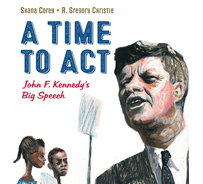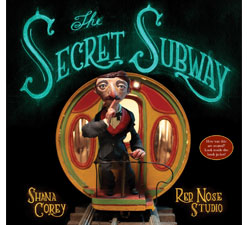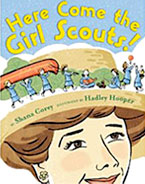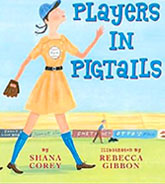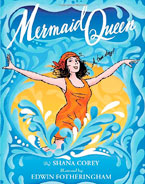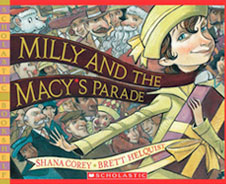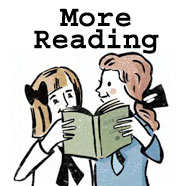Kids’ books are a great way to explore history! You can download an EDUCATORS GUIDE here. Or click on a book or read on if you’d like suggestions for further reading, Girl Scout and Brownie Badges, as well as links to lesson plans and ways to use my books with Common Core Standards. (Be sure to preview the links and books to make sure they’re appropriate before sharing with your kids.)
A Time To Act: John F. Kennedy’s Big Speech
Click here to view the trailer!
Click here for the Discussion Guide! (It will take a few seconds to load.)
For interviews and blog reviews on A Time To Act, check out:
Want to find out more?
- If you’re in Boston, you can visit John F. Kennedy’s childhood home and the John F. Kennedy Library. The JFK library also has extensive exhibits online, including most of the speeches and documents referenced in this book.
- You can watch JFK’s Address to the American People on Civil Rights here.
- You can also watch his Inaugural address, his 1961 remarks at the Berlin Wall and his 1962 speech about the space race.
Primary sources!
Primary sources are records by those who actually witnessed or participated in a historical event or time period. Primary sources such as interviews, diaries, letters and speeches are a great window into the past and my favorite part of research. (Can you think of primary sources that future historians might use to learn about your life?).
In addition to the speeches above, here are some of the primary sources I found most interesting when I was researching this book.
- Jack’s letter to his dad, asking for a raise in his allowance, and a report his school wrote to his father about his disorderliness can be found here. (I loved getting a glimpse of Jack’s personality as a child-both first hand and as seen by his teachers).
I also loved seeing Jack’s interactions with other change-makers-they reminded me that historical figures are also real people and that history isn’t just one person’s story, it’s a conversation and there are lots of voices interacting with and influencing each other. I think seeing those interactions play out in their own words is goosebumps cool! Click here to see one of Eleanor Roosevelt’s telegrams to Jack.
- Click here to see a letter from Jackie Robinson to Jack after he was elected.
- And here to see Jackie Robinson’s Press Release after Jack’s Civil Rights Address.
- Click here to see Martin Luther King’s Telegram in response to Jack’s Address on Civil Rights.
For further reading about John F. Kennedy check out::
The Brothers Kennedy by Kathleen Krull
Jack’s Path of Courage: The Life of John F. Kennedy by Doreen Rappaport
For great books on the Civil Rights movement and some of the people mentioned in this book, check out:
Dream March: Dr. Martin Luther King, Jr. and the March on Washington by Vaunda Micheaux Nelson
I Have a Dream by Dr. Martin Luther, King, illustrated by Kadir Nelson
Jackie Robinson: American Hero by Sharon Robinson
Martin’s Big Words: The Life of Dr. Martin Luther King, Jr. by Doreen Rappaport
Sit-In: How Four Friends Stood Up By Sitting Down by Andrea Davis Pinkney
Through My Eyes by Ruby Bridges
Turning 15 on the Road to Freedom: My Story of the Selma Voting Rights March by Lynda Blackmon Lowery
And teachers, check out these related lesson plans!
- The President Takes a Stand
- They Had a Dream
- Youth in Action
- Race to the Moon
- Eleanor Roosevelt and John F. Kennedy
The Secret Subway
Click here to view the trailer!
For interviews and blog reviews on The Secret Subway, check out:
- NY1 In Transit
- 100 Scope Notes
- Kirkus Reviews
- Huffington Post
- What to Read to Your Kids
- Waking Brain Cells
- Elizabeth O. Dulemba
- Audrey Vernick
- Heather Lang Books
Alfred Ely Beach was a MAKER. He used ingenuity and science to solve a real world problem (traffic in New York City!). For a peek at New York City’s traffic in Alfred Ely Beach’s time-click here. How would YOU solve the traffic problem?
The Science Connection!
Beach’s pneumatic subway used air to send it back and forth in the tunnel. For lessons and fun activities that use air power, check out these resources.
The New York City Subway:
You can learn more about the New York City subway at the New York Transit Museum in Brooklyn or at the museum’s online home here.
Click here for lesson plans.
And here for activities and games.
For more on Alfred Ely Beach including primary source documents and photographs, click here.
Or read Beach’s The Illustrated Description of the Broadway Pneumatic Underground Railway (Published by SW Green, 1870)
The band Klaatu also wrote a song about Beach’s subway. You can listen to it here!
New York City History:
You can visit the Museum of the City of New York, New York’s Tenement Museum, and the Dimenna Children’s History Museum at the New York Historical Society.
Check out these excellent NYC themed resources for teachers:
- http://www.newnetherlandinstitute.org/education/for-teachers/
- http://www.nps.gov/elis/learn/education/classrooms/curriculummaterials.htm
- http://www.scholastic.com/teachers/lesson-plan/immigration-lesson-plan-grades-k-2
- http://artsedge.kennedy-center.org/educators/lessons/grade-3-4/Musical_Harlem.aspx
- http://www.esbnyc.com/explore/education/social-studies-grades-3-5
- http://www.pbs.org/wgbh/americanexperience/features/teachers-resources/newyork-teachers-guide/
- http://www.skyscraper.org/EDUCATION/ed_resources.htm
- https://www.pbs.org/wnet/newyork/laic/lessons/e4_t4-lp.html
And for a more recent subway story, check out: The Subway Story, by Julia Sarcone-Roach
And for a fun fictional novel (and great read aloud) about New York City traffic, read: The Pushcart War, by Jean Merrill
Here Come the Girl Scouts!
For interviews and blog reviews on Here Come the Girl Scouts, check out:
- Kirkus Reviews
- The Nonfiction Detectives
- Children’s Book-a-Day Almanac
- Reading is Fundamental
- 100 Scope Notes
- Q&A – Scholastic
- The Children’s Book Review
- Adventures in Parenting
- sharpread
- Motherreader
- Podcast – International Reading Association
- My Guest Post for Kidlit Celebrates Women’s History Month
- SavannahNow Interview
- Watch. Connect, Read. Exploring Children’s Literature Through Book Trailers
- Teach Mentor Texts
Celebrate 100 years of Girl Scouts!
In 2012, the Girl Scouts celebrate their 100th birthday! You can celebrate by having a Happy Birthday, Girl Scouts party of your own. Start by reading Here Come the Girl Scouts! Then do some of the things the first Girl Scouts did, like going on a picnic, taking a nature walk, collecting leaves or flowers, planting a tree, or playing basketball (bloomers and hair bows not required!). You can also contact me to find out how to set up a skype visit with your troop!
Click here or here to see other ideas for celebrating.
Petals and Badges
Here Come the Girl Scouts! can also work with many Daisy Petals and Brownie and Girl Scout Badges. Note, it’s NOT part of the Girl Scout program or required reading for any Petals or Badges, it’s just a fun extra and a way to learn more about the Girl Scout who started it all! Here are a few ideas (please refer to your Girl’s Guide to Girl Scouting for the complete badge and petal requirements.).
Daisy Petals
Tula Petal
The Tula Petal is all about being courageous and strong—just like Daisy Low! Read Here Come the Girl Scouts! with your troop or family. Discuss what the words courageous and strong mean to you. Do you think those words describe Daisy? Why? Tell about a time you were courageous and strong.
Part of getting a Tula Petal is to make an art gallery of strong and courageous women. Draw a picture of a woman that you think has those qualities (it can be Daisy, but it doesn’t have to be.).
Another part of getting your Tula petal is to practice being courageous and strong! Your Girl’s Guide to Girl Scouting has lots of great ways to do this. One of them is to find a person who is courageous and strong in real life or in a book (or in both, like Daisy!). Read Here Come the Girl Scouts! with someone in your family if you’d like to choose Daisy. (You don’t have to pick Daisy—see the book lists below for picture books about other strong and courageous women.) Then tell your family about that the woman you chose and why you think she was courageous and strong.
Rosie Petal
Here Come the Girl Scouts! can also tie in with the Rosie Petal. Read Here Come the Girl Scouts! Daisy believed that her Girl Scouts could make the world a better place. What are some ways that Daisy Low made the world better? The last two pages of the book before the author’s note show some well known Girl Scout alums. How have they and other Girl Scouts gone on to make the world a better place? How would you like to make the world a better place?
Gloria Petal
Part of the Gloria Petal is to practice respecting yourselves and others. One way to do this is think of three healthy things you can do to show that you respect yourselves—like getting exercise every day. Read Here Come the Girl Scouts!, can you find ways that Daisy and the first Girl Scouts showed they respected themselves?
Brownie Badges
The Girl Scout Way
Your Girl’s Guide to Girl Scouting has seven Legacy badges, which are based on things the very first Girl Scouts were doing! Can you find some activities in Here Come the Girl Scouts! that Girl Scouts are still doing? One of the Legacy badges is The Girl Scout Way.
Part of earning your Girl Scout Way badge is to celebrate Daisy’s Low’s birthday. One way to do this is to throw a birthday party! What does Here Come the Girl Scouts! tell you about Daisy’s personality? Based on the stories in the book, how do you think Daisy might have liked to celebrate? (Here’s a fun Daisy story. Once Daisy was throwing a garden party-but the flowers in her garden hadn’t bloomed in time for the party. So what do you think Daisy did? She borrowed flowers from her neighbors’ gardens and tied them to her own trees, of course!) Plan your party to include some things you think Daisy would have enjoyed!
Another way to celebrate is to make a card for a Girl Scout Daisy you know. Tell some of your favorite Daisy Low stories in the card. (Extra: You can also read Here Come the Girl Scouts! to her and let her tell you her favorite things about Daisy!)
Here Come the Girl Scouts! can also tie in with badges like Naturalist and Hiker, and for Juniors‑Scribe, Gardener and Camper because these things were an important part of Girl Scouts from the very start. Many of the quotes in Here Come the Girl Scouts!‑such as “fresh air is your great friend”‑come from the very first Girl Scout handbook from 1913. Read some of them, then discuss with your troop what these quotes mean. Are they still relevant today?
Junior Badges
The Girl Scout Way
Part of earning this badge is to celebrate the Girl Scout birthday, March 12, 1912 (You can see what that first meeting might have looked like and learn about what first troop did in Here Come the Girl Scouts!).
Your Girl’s Guide to Girl Scouting has lots of fun ways to celebrate. One is to read about Daisy Low (you can read Here Come the Girl Scouts! or another book) and then make up a play, story, or a mural about the first Girl Scouts. Can you imagine being in that first troop in 1912? What are some of the things the first Girl Scouts did that Girl Scouts still do? What are some things that have changed? What do you think they did at the first meeting?
Another way to celebrate is to help a Brownie or Daisy group plan their own celebration. This might include planting a tree. You might begin by reading Here Come the Girl Scouts! to the younger girls. Point out to them how being outside and protecting nature was something that was important to the Girl Scouts even back in 1912. Discuss why planting trees and enjoying nature was important in Daisy’s time and in ours. Then help the girls plant a tree to honor Daisy.
Playing the Past
Playing the Past would have been my favorite badge when I was growing up! It lets you step into the past and be anyone you want‑someone real, like Daisy, or someone from your imagination!
Part of the badge is to write a diary or a speech in your character’s voice. Read Here Come the Girl Scouts! What do you think it would have been like to be one of the very first Girl Scouts? Pretend you’re trying to talk your parents into letting you join a new organization called the Girl Scouts—what would you say? Why should they let you join? Why do you want to join? What would you say if you were inviting a friend to join? Now imagine Daisy’s famous call to her cousin. Daisy said, “Come right over! I’ve got something for the girls of Savannah, and all America, and all the world, and we’re going to start it tonight!” How do you think the rest of the call might have gone? (Note, you don’t have to pick Daisy to be your character—you can be anyone you’d like! For other ideas, check out the book lists below. If you read You Forgot Your Skirt, Amelia Bloomer!, what do you think Amelia Bloomer really thought about the clothes women wore in the 1800s?)
With all of these ideas, please refer to your Girl’s Guide to Girl Scouting for the full requirements. Have fun!
Additional Resources
To learn more about Juliette Gordon Low and the Girl Scouts, you can visit the Juliette Gordon Low Birthplace.
The Girl Scout National Historic Preservation Center
You can also read these books:
How Girls Can Help Their Country: Handbook for Girl Scouts by W. J. Hoxie
Helping Hands: A Paper Doll History of the Girl Scout Uniform by Kathryn McMurtry Hunt
First Girl Scout: The Life of Juliette Gordon Low by Ginger Wadsworth
For adults:
Juliette Gordon Low: The Remarkable Founder of the Girl Scouts by Stacy A. Cordery
Lady from Savannah: The Life of Juliette Low by Gladys Denny Shultz and Daisy Gordon Lawrence
You Forgot Your Skirt, Amelia Bloomer!
March is Women’s History Month, but you can celebrate women’s history anytime!
For more about inspiring women in history, check out the National Women’s Hall of Fame.
You can also visit Scholastic’s website and join kids across the nation in nominating women for Scholastic’s Honor Roll of Notable Women.
Teachers, you can get lesson plans using You Forgot Your Skirt, Amelia Bloomer from Scholastic here.
And from the Brooklyn Public Library.
And suggestions for using all of my books with Common Core Standards from School Library Journal here.
Here are some links to additional women’s history lesson plans.
- Women Who Changed History: Student Activities
- Educating Jane: Women’s History Month
- Teaching With Historic Places: Women’s History
For further reading about the suffrage movement, check out:
The Ballot Box Battle by Emily Arnold McCully
Elizabeth Leads the Way: Elizabeth Cady Stanton and the Right to Vote by Tanya Lee Stone
Girls Think of Everything: Stories of Ingenious Inventions by Women by Catherine Thimmesh
I Could Do That! Esther Morris Gets Women the Vote by Linda Arms White
You Want Women to Vote, Lizzie Stanton? by Jean Fritz
33 Things Every Girl Should Know About Women’s History: From Suffragettes to Skirt Lengths to the E.R.A. by Tonya Bolden
For more groundbreaking women in history, check out these books (also see Players in Pigtails and Mermaid Queen sections for books about women in sports):
Almost Astronauts: 13 Women Who Dared to Dream by Tanya Lee Stone
Amelia and Eleanor Go for a Ride by Pam Muñoz Ryan
The Bravest Woman in America by Marissa Moss
Eleanor by Barbara Cooney
Emily by Michael Bedard
Fannie in the Kitchen: The Whole Story from Soup to Nuts of How Fannie Farmer
Invented Recipes with Precise Measurements by Deborah Hopkinson
Fly High! The Story of Bessie Coleman by Louise Borden and Mary Kay Kroeger
Ruth Law Thrills a Nation by Don Brown
Frida by Jonah Winter
Lives of Extraordinary Women: Rulers, Rebels (and What the Neighbors Thought) by Kathleen Krull
Uncommon Traveler: Mary Kingsley in Africa by Don Brown
What to Do About Alice? by Barbara Kerley
Me . . . Jane by Patrick McDonnell
My Name Is Georgia: A Portrait by Jeanette Winter
Nobody Owns the Sky: The Story of “Brave Bessie” Coleman by Reeve Lindbergh
Only Passing Through: The Story of Sojourner Truth by Anne Rockwell
Outrageous Women series by Vicki Leon
Tillie the Terrible Swede: How One Woman, a Sewing Needle, and a Bicycle Changed History by Sue Stauffacher
The Watcher: Jane Goodall’s Life with the Chimps by Jeanette Winter
Also check out the American Library Association’s Amelia Bloomer Project for more book lists.
Players in Pigtails
Did you know that the first verse of the song “Take Me Out to the Ballgame” is about a girl? It’s true! Girls and women have played and loved sports for centuries, even though it wasn’t always considered “proper” behavior. For more on the groundbreaking All-American Girls Professional Baseball League, check out the AAGPBL website.
You can also visit the Women in Baseball exhibit at the National Baseball Hall of Fame.
Lesson plans on women in baseball, and this one focusing on Players in Pigtails, are available through the National Baseball Hall of Fame, and here from Weston Woods.
Click here to see the real All American Girls Professional Baseball League Players in action!
You can also order the audio or video versions of Players in Pigtails and view a video clip, here.
For a time line of women in sports, click here.
Further reading:
Dirt on Their Skirts by Doreen Rappaport and Lyndall Callan
Girl Wonder: A Baseball Story in Nine Innings by Deborah Hopkinson
Mighty Jackie: The Strike-Out Queen by Marissa Moss
Rosie the Riveter: Women Working on the Home Front in World War II by Penny Colman
She Loved Baseball: The Effa Manley Story by Audrey Vernick
A Whole New Ball Game: The Story of the All-American Girls Professional Baseball League by Sue Macy
For more books on women in sports, scroll down to the Mermaid Queen section.
Mermaid Queen:
The Spectacular True Story of Annette Kellerman, Who Swam Her Way to Fame, Fortune & Swimsuit History!
In 1952, Esther Williams starred in a movie spectacular about Annette Kellerman’s life, The Million Dollar Mermaid. You can see the trailer here.
For other books on women in sports, check out the baseball books mentioned under Players in Pigtails or these books:
America’s Champion Swimmer: Gertrude Ederle by David A. Adler
Wilma Unlimited: How Wilma Rudolph Became the World’s Fastest Woman by Kathleen Krull
Milly and the Macy’s Parade
Happy Thanksgiving!
Did you know that the famous Macy’s Thanksgiving Parade really was begun by immigrant employees who worked at Macy’s in the 1920s and were homesick for their holidays back home?
Lesson plans on Milly and the Macy’s Parade are available online from Scholastic.
PBS Kids also has a great New York City history site here.
For further reading on Thanksgiving and the Macy’s Parade:
Balloons Over Broadway by Melissa Sweet
Macy’s Thanksgiving Day Parade by Robert M. Grippo and Christopher Hoskins
Thank You, Sarah: The Woman Who Saved Thanksgiving by Laurie Halse Anderson
For more New York City books, check out:
Dizzy by Jonah Winter
Duke Ellington: The Piano Prince and His Orchestra by Andrea Davis Pinkney
Fireboat: The Heroic Adventures of the John J. Harvey by Maira Kalman
Grandma’s Records by Eric Velasquez
The Little Red Lighthouse and the Great Gray Bridge by Hildegarde H. Swift and Lynd Ward
The Man Who Walked Between the Towers by Mordicai Gerstein
Mermaids on Parade by Melanie Hope Greenberg
Sky Boys: How They Built the Empire State Building by Deborah Hopkinson
My Chinatown: One Year in Poems by Kam Mak
My New York by Kathy Jakobsen
My Subway Ride by Paul Dubois Jacobs and Jennifer Swender
Next Stop Grand Central by Maira Kalman
Skit-Scat Raggedy Cat: Ella Fitzgerald by Roxane Orgill
Tar Beach by Faith Ringgold
Twenty-One Elephants by Phil Bildner
Uptown by Bryan Collier
And for older kids:
All-of-a-Kind Family series by Sydney Taylor (though this makes a great read-aloud for kids as young as four)
From the Mixed-Up Files of Mrs. Basil E. Frankweiler by E. L. Konigsburg
Harriet the Spy by Louise Fitzhugh
In the Year of the Boar and Jackie Robinson by Bette Bao Lord
Tales of a Fourth Grade Nothing by Judy Blume
When You Reach Me by Rebecca Stead
And if you’ve made it this far, may I recommend some of my other favorite history related picture books and early readers. (These aren’t about New York City or women’s history, but are delightful.)
Abe Lincoln Crosses a Creek: A Tall Thin Tale by Deborah Hopkinson
Babe Ruth Saves Baseball! by Frank Murphy
Eat My Dust! Henry Ford’s First Race by Monica Kulling
The Fantastic Undersea Life of Jacques Cousteau by Dan Yaccarino
George Washington and the General’s Dog by Frank Murphy
The Legend of the Teddy Bear by Frank Murphy
Lewis and Clark: A Prairie Dog for the President by Shirley Raye Redmond
Thomas Jefferson’s Feast by Frank Murphy

